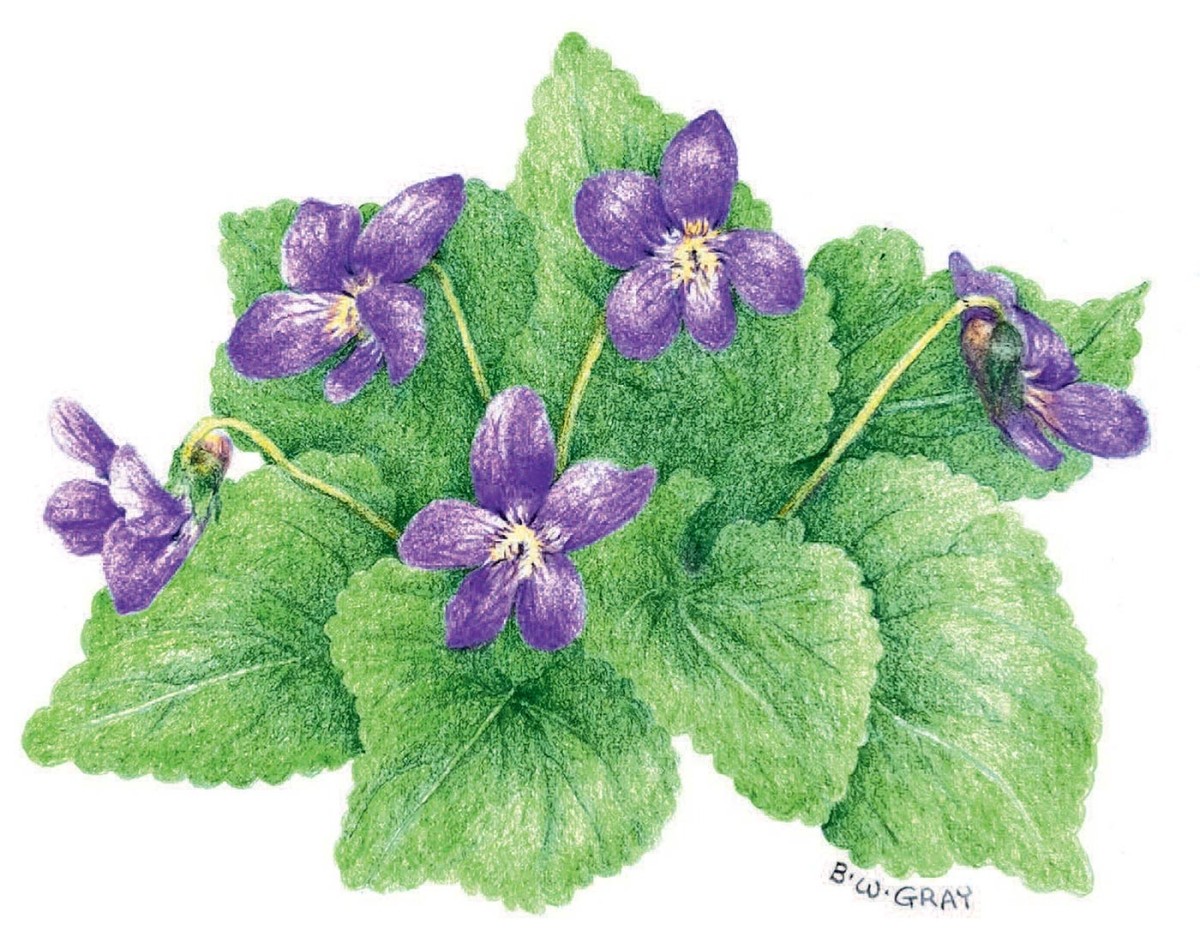One of my favorite foraging memories is the first time that my wife and I made violet jelly. We’d gathered several cups of violet flowers from a suburban yard. Our recipe called for lemon juice, and to our surprise and delight, the acid instantly changed the violet infusion from a light blue color to a brilliant purple. It was pure magic. And, indeed, who hasn’t thought of violets, those champions of spring, as magical?
There are many species of violets (genus Viola) in New England. Arthur Haines, senior research botanist with the Native Plant Trust, lists 30 in his book, Flora Novae Angliae. On top of that, violets hybridize frequently. This can make identification challenging. Using a good key to identify violet species is a worthy exercise, but don’t despair if a clear-cut identification eludes you. Knowing a plant is a member of the violet genus is relatively easy and sufficient for the casual forager, since no violets are poisonous.
Violets are low-growing herbs with flowers that bloom in spring. These flowers are most commonly blue or purple but some species in our area are white, yellow, or in the case of one species, even green. Some have variable colors. The flowers are distinctive with five petals. Two open out to one side, two open out to the other. The fifth sticks out from below the others like a tongue and has a spur protruding from the back. The most common violet species have no leaves on the flower stalks. Their leaves, instead, grow from the base. In most, leaves grow singly, are roughly heart- or kidney-shaped, and are slightly toothed.
There are some poisonous plants, including monkshoods (Aconitum spp.) and larkspurs (Delphinium spp.) whose flowers bear a passing resemblance to violets in both color and shape. Unlike most violets, however, these species have deeply cut leaves. Their flowers also grow on taller stalks and, unlike violets, in heads bearing multiple flowers. Lesser celandine (Ficaria verna), another poisonous plant, has leaves similar to some violet leaves, but its flowers are distinctive. The cautious novice can simply wait until flowering to be sure of identification.
In addition to safety, another good reason for careful identification is to ensure that you don’t gather a sensitive or endangered species. For example, the New England violet (Viola novae-angliae) of northern Maine is a rare and beautiful violet worth knowing by anyone who forages in its range, so that it can be protected and conserved.
One of the best ways to ensure sustainable violet harvests is to gather from places that humans commonly and constantly disturb – their lawns. These are the preferred habitats of several common species which, besides being abundant, are also some of the best tasting. Some foragers claim that yellow violet species can be irritatingly high in saponins; I have never tested this as all the yellow species are uncommon in my area.
To gather violets, I look for the light blue and purple confetti in lawns that haven’t been treated with herbicides. Depending on what I am planning to do with the violets, I either gather the leaves or the flowers, removing the stems from both. The early leaves in spring are tender, and I add them into salads where their mild flavor is best complemented by more flavorful greens. Later in the season, leaves grow tougher, and I like to wilt them in a little butter or bacon fat. Some people will boil them as a potherb, but I find they cook down quite a lot and have little flavor after boiling.
My favorite thing about violets will always be the delicate flavor and beautiful color of violet jelly. There is nothing like spreading a little bit of violet sweetness on an oven-hot biscuit to make one long for spring, no matter what time of year it is.
Violet Jelly
Makes four 4 oz. jars
Ingredients
2 cups violet flowers (stems removed)
¼ cup lemon juice
1¾ oz. package of pectin
2 cups sugar
Steep violet flowers in 2 to 4 cups of warm (but not boiling) water for about 45 minutes.
Add lemon juice and enjoy some colorful chemistry.
Strain the flowers from the infusion and discard. Pour 2 cups of the liquid into a medium saucepan. Add pectin and bring to a rolling boil for at least 1 minute. Stir in the sugar until dissolved and return to a boil for another minute.
Remove from the heat and immediately ladle into sterilized canning jars, and seal.


